INSTITUT SUPERIEUR D'ANTHROPOLOGIE
INSTITUT OF ANTHROPOLOGY
COURS ONLINE – COURS A DISTANCE
INSCRIPTIONS : SEPTEMBRE 2024
REGISTER NOW
ISRAEL – 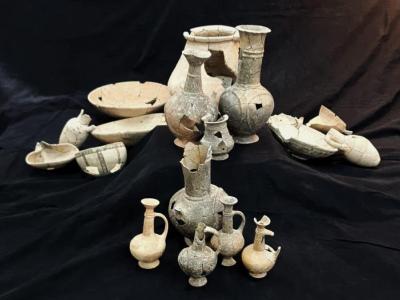 Tel Yehud - A group of archaeologists found opium residues in ceramic vessels in Israel dating back to the 14th century BC, and they claim that This is the first known evidence of the use of psychoactive drugs in the world, Tel Aviv University reported today. Opium residues were found in ceramic vessels, apparently used in funerary rituals, that were found in Canaanite tombs in Tel Yehud, central Israel. The expert assures that it cannot yet be determined if the Canaanites of Yehud believed that the dead would need opium in the afterlife, or if it was the priests who consumed the drug to officiate the ceremony, but she assured that the discovery sheds light on the trade. of opium in general. Opium is produced from the poppy, which grew in Asia Minor, in modern-day Turkey, while the ceramics in which opium was identified were made in Cyprus. «In other words, the opium was brought to Yehud from Türkiye, through Cyprus; "This indicates the importance attributed to the drug.", describes Linares. In 2012, the AAI carried out a salvage excavation at the Tel Yehud site, before residences were built. Several Canaanite tombs from the Late Bronze Age were found there and, next to them, funerary offerings, many of them ceramic vessels. Those made in Cyprus and called "base ring jars" have a shape similar to that of a poppy flower when closed and upside down, so in the 19th century the hypothesis arose that they were used as ritual containers for drug. Now, thanks to an analysis of organic waste, «Remains of opium have been revealed in eight vessels, some local and others manufactured in Cyprus. "It is the first time that opium has been found in ceramics in general, and in base ring vessels in particular."said Tel Aviv University.
Tel Yehud - A group of archaeologists found opium residues in ceramic vessels in Israel dating back to the 14th century BC, and they claim that This is the first known evidence of the use of psychoactive drugs in the world, Tel Aviv University reported today. Opium residues were found in ceramic vessels, apparently used in funerary rituals, that were found in Canaanite tombs in Tel Yehud, central Israel. The expert assures that it cannot yet be determined if the Canaanites of Yehud believed that the dead would need opium in the afterlife, or if it was the priests who consumed the drug to officiate the ceremony, but she assured that the discovery sheds light on the trade. of opium in general. Opium is produced from the poppy, which grew in Asia Minor, in modern-day Turkey, while the ceramics in which opium was identified were made in Cyprus. «In other words, the opium was brought to Yehud from Türkiye, through Cyprus; "This indicates the importance attributed to the drug.", describes Linares. In 2012, the AAI carried out a salvage excavation at the Tel Yehud site, before residences were built. Several Canaanite tombs from the Late Bronze Age were found there and, next to them, funerary offerings, many of them ceramic vessels. Those made in Cyprus and called "base ring jars" have a shape similar to that of a poppy flower when closed and upside down, so in the 19th century the hypothesis arose that they were used as ritual containers for drug. Now, thanks to an analysis of organic waste, «Remains of opium have been revealed in eight vessels, some local and others manufactured in Cyprus. "It is the first time that opium has been found in ceramics in general, and in base ring vessels in particular."said Tel Aviv University.
Des archéologues découvrent en Israël la première preuve de consommation d'opium au monde (aurora-israel.co.il)
ISRAEL –  Tel Yavne - The Israel Antiquities Authority has just announced an impressive find that can be considered a "Hanukkah Gift." It is a small clay vessel that contained seven gold coins from the region's early Islamic period. The find was made at the construction site of a new Tel Yavne neighborhood where, due to its archaeological importance, the Antiquities Authority established an excavation. The site appears to have been an important industrial center at the time, which remained active for several hundred years. The discovery of what could have been the piggy bank with a potter's savings occurred suddenly and due to its importance it attracted the attention of specialists, Liat Nadav-Zit, Dr. Elie Haddad and Marc Molkondov, who were among the first to record it and celebrate it. The gold coins were dated to the 786th century CE. Along with these, a dinar belonging to the dynasty of Caliph Haroun A-Rashid was also found, which inspired the tales of "One Thousand and One Nights" between 809 and XNUMX CE. These coins are very rare to find in Israel and having appeared during the Hanukkah celebration, experts have considered them to be a true "Hanukkah Gelt" or Hanukkah gift.In another area of the same excavation area, a commercial wine production complex dating from the Persian period, 4th and 5th centuries BCE, was discovered. The excavation area, southeast of Tel Yavne, has been shown to have been a large industrial establishment of the late Byzantine period and early Islamic period, between the 7th and 9th centuries CE.
Tel Yavne - The Israel Antiquities Authority has just announced an impressive find that can be considered a "Hanukkah Gift." It is a small clay vessel that contained seven gold coins from the region's early Islamic period. The find was made at the construction site of a new Tel Yavne neighborhood where, due to its archaeological importance, the Antiquities Authority established an excavation. The site appears to have been an important industrial center at the time, which remained active for several hundred years. The discovery of what could have been the piggy bank with a potter's savings occurred suddenly and due to its importance it attracted the attention of specialists, Liat Nadav-Zit, Dr. Elie Haddad and Marc Molkondov, who were among the first to record it and celebrate it. The gold coins were dated to the 786th century CE. Along with these, a dinar belonging to the dynasty of Caliph Haroun A-Rashid was also found, which inspired the tales of "One Thousand and One Nights" between 809 and XNUMX CE. These coins are very rare to find in Israel and having appeared during the Hanukkah celebration, experts have considered them to be a true "Hanukkah Gelt" or Hanukkah gift.In another area of the same excavation area, a commercial wine production complex dating from the Persian period, 4th and 5th centuries BCE, was discovered. The excavation area, southeast of Tel Yavne, has been shown to have been a large industrial establishment of the late Byzantine period and early Islamic period, between the 7th and 9th centuries CE.
1.200-year-old coins found in Israel (aurora-israel.co.il)
MONGOLIE – 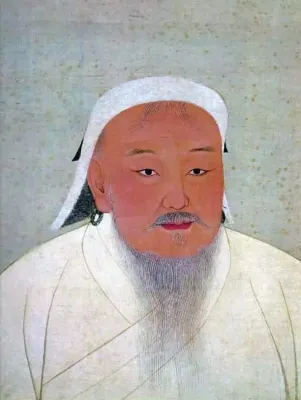 Burkhan Khaldun - Genghis Khan died in 1227 C.E. after having conquered a territory twice the size of the Roman Empire. His last wish was to be buried in secret, something his soldiers accomplished in two ways: by killing everyone they met en route to the gravesite, and then trampling that site under the hoofs of their horses until no trace was left. To this day, the location of the Khan’s final resting place—rumored to contain various treasures collected on his globe-spanning military campaigns—remains unknown. Many archaeologists and historians now believe the tomb may be located on Burkhan Khaldun, a peak in the Khentii Mountains north of Ulaanbaatar where Genghis Khan hid from his enemies as a young man and pledged to return after he died, according to some sources. Unfortunately for these experts, the peak falls under a protected wildlife conservation area that the Mongolian government does not permit anyone to enter for any reason, whether spiritual or scientific. Perhaps the closest anyone has come to finding the tomb of Genghis Khan was in 2015, when French archaeologist Pierre-Henri Giscard and imaging expert Raphaël Hautefort employed drones to scout Burkhan Khaldun’s summit. Although they reportedly came across a manmade tumulus, there is currently no way of learning what—if anything—awaits inside.
Burkhan Khaldun - Genghis Khan died in 1227 C.E. after having conquered a territory twice the size of the Roman Empire. His last wish was to be buried in secret, something his soldiers accomplished in two ways: by killing everyone they met en route to the gravesite, and then trampling that site under the hoofs of their horses until no trace was left. To this day, the location of the Khan’s final resting place—rumored to contain various treasures collected on his globe-spanning military campaigns—remains unknown. Many archaeologists and historians now believe the tomb may be located on Burkhan Khaldun, a peak in the Khentii Mountains north of Ulaanbaatar where Genghis Khan hid from his enemies as a young man and pledged to return after he died, according to some sources. Unfortunately for these experts, the peak falls under a protected wildlife conservation area that the Mongolian government does not permit anyone to enter for any reason, whether spiritual or scientific. Perhaps the closest anyone has come to finding the tomb of Genghis Khan was in 2015, when French archaeologist Pierre-Henri Giscard and imaging expert Raphaël Hautefort employed drones to scout Burkhan Khaldun’s summit. Although they reportedly came across a manmade tumulus, there is currently no way of learning what—if anything—awaits inside.
The Hunt: Genghis Khan’s Final Resting Place (artnet.com)
ANGLETERRE -  Chichester - The Chichester and District Archaeology Society team, led by Chichester District Council’s archaeologist James Kenny, found the Norman military structure during their current excavation in Priory Park, Chichester. The dig began on May 21 and is set to end on Monday. It is the seventh dig to take place at the site, with last year’s dig uncovering the remains of a ditch and the foundations of a building that was part of a medieval Franciscan Friary. Other discoveries include fragments of decorative floor tiles from the late medieval period and roofing materials and other floor tile remains believed to be from the Tudor period. “We have been continuing the work that we did last year, focusing on the park’s Norman history, and we’ve been fortunate enough to uncover the structure of a bridge that would have spanned the ditch surrounding the central mound, or ‘motte’,” explains Chichester District Council’s archaeologist, James Kenny. The archaeologists’ work this year was informed by a series of geophysics and ground-penetrating radar scans. “As part of the excavation, we have found key architecture that would have formed the structure of the bridge, including a robust corner block — or ‘quoin’ — made of limestone, which would have been imported for the purpose. We have also discovered putlog holes, which are holes that oak beams would have been inserted into to help form a scaffolding system that would have been used while building the structure. The level of the putlog holes indicate that the ground level at the time would have been at least six feet lower, but could have been much deeper.” “The structure is extremely impressive and solidly constructed. Norman soldiers would have used this bridge as a means of protecting the city’s castle. They would have crossed the bridge on wooden beams over the masonry — on foot, by horse, or with carts — and then removed the beams after use so that invaders wouldn’t be able to cross to the motte. Our finds indicate that the bridge may have been constructed in phases as the Normans settled and the castle was used on a more permanent basis,” Mr Kenny continued. The motte and bailey castle was probably built directly after the Norman Invasion in 1067 or 1068 by Earl Roger Montgomery. Controlling most of what would become West Sussex, he was one of the most influential Norman barons. The motte was once a major structure, four or five times larger than it is now, and most likely comparable in size to the one at Arundel Castle. Today, only a small portion of the motte remains. The purpose of Chichester’s castle was to terrify the urban English populace and discourage them from rising up against their new Norman overlords.
Chichester - The Chichester and District Archaeology Society team, led by Chichester District Council’s archaeologist James Kenny, found the Norman military structure during their current excavation in Priory Park, Chichester. The dig began on May 21 and is set to end on Monday. It is the seventh dig to take place at the site, with last year’s dig uncovering the remains of a ditch and the foundations of a building that was part of a medieval Franciscan Friary. Other discoveries include fragments of decorative floor tiles from the late medieval period and roofing materials and other floor tile remains believed to be from the Tudor period. “We have been continuing the work that we did last year, focusing on the park’s Norman history, and we’ve been fortunate enough to uncover the structure of a bridge that would have spanned the ditch surrounding the central mound, or ‘motte’,” explains Chichester District Council’s archaeologist, James Kenny. The archaeologists’ work this year was informed by a series of geophysics and ground-penetrating radar scans. “As part of the excavation, we have found key architecture that would have formed the structure of the bridge, including a robust corner block — or ‘quoin’ — made of limestone, which would have been imported for the purpose. We have also discovered putlog holes, which are holes that oak beams would have been inserted into to help form a scaffolding system that would have been used while building the structure. The level of the putlog holes indicate that the ground level at the time would have been at least six feet lower, but could have been much deeper.” “The structure is extremely impressive and solidly constructed. Norman soldiers would have used this bridge as a means of protecting the city’s castle. They would have crossed the bridge on wooden beams over the masonry — on foot, by horse, or with carts — and then removed the beams after use so that invaders wouldn’t be able to cross to the motte. Our finds indicate that the bridge may have been constructed in phases as the Normans settled and the castle was used on a more permanent basis,” Mr Kenny continued. The motte and bailey castle was probably built directly after the Norman Invasion in 1067 or 1068 by Earl Roger Montgomery. Controlling most of what would become West Sussex, he was one of the most influential Norman barons. The motte was once a major structure, four or five times larger than it is now, and most likely comparable in size to the one at Arundel Castle. Today, only a small portion of the motte remains. The purpose of Chichester’s castle was to terrify the urban English populace and discourage them from rising up against their new Norman overlords.
Archaeologists find remains of Norman Bridge during dig in Chichester's Priory Park, England - Arkeonews
NORVEGE – 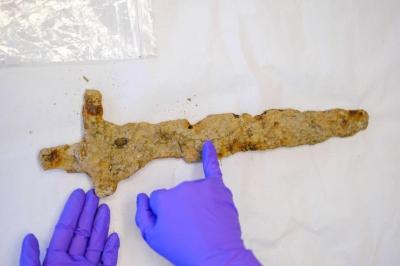
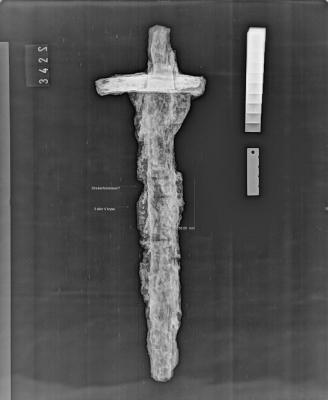 Suldal - A farmer and his son found a rare Viking sword on his family farm in Suldal, Norway. Archaeologists say this is probably the first time a sword like this has been found in Rogaland. The Norwegian municipality of Suldal is located in the northeastern part of Rogaland County. The weapon was found to be a rare Viking sword that dates between 900 and 1050 by archaeologists. Slightly shorter than half of its original length, the well-preserved sword measures about 15 inches (37cm). Its T-shaped handle is easy to identify, and its end appears blunt and rectangular. According to the Gulating Law, the oldest surviving Norwegian legal text, the sword was a mandatory weapon free men had to carry when attending the assembly. An X-ray study of the artifact has provided scientists with valuable information. Archaeologists X-rayed the sword and were surprised to find an inscription on the blade, the museum said. The inscription included a cross pattern and possibly some writing. This recent discovery could be a renowned VLFBERHT sword from the Viking Age or the early Middle Ages. Sigmund Oehrl, a Professor of archeology at the University of Stavanger, explains that these were high-quality swords produced in the Frankish Empire (now Germany) and were marked with the weapon manufacturer’s name.
Suldal - A farmer and his son found a rare Viking sword on his family farm in Suldal, Norway. Archaeologists say this is probably the first time a sword like this has been found in Rogaland. The Norwegian municipality of Suldal is located in the northeastern part of Rogaland County. The weapon was found to be a rare Viking sword that dates between 900 and 1050 by archaeologists. Slightly shorter than half of its original length, the well-preserved sword measures about 15 inches (37cm). Its T-shaped handle is easy to identify, and its end appears blunt and rectangular. According to the Gulating Law, the oldest surviving Norwegian legal text, the sword was a mandatory weapon free men had to carry when attending the assembly. An X-ray study of the artifact has provided scientists with valuable information. Archaeologists X-rayed the sword and were surprised to find an inscription on the blade, the museum said. The inscription included a cross pattern and possibly some writing. This recent discovery could be a renowned VLFBERHT sword from the Viking Age or the early Middle Ages. Sigmund Oehrl, a Professor of archeology at the University of Stavanger, explains that these were high-quality swords produced in the Frankish Empire (now Germany) and were marked with the weapon manufacturer’s name.
A farmer picking up ‘trash’ in field in Norway discovered a rare Viking Sword - Arkeonews
GRECE – 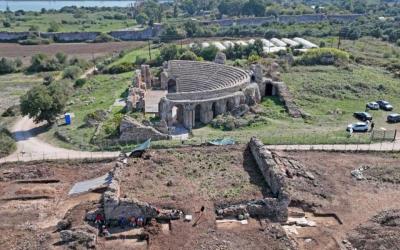 Nikopolis - The Greek Ministry of Culture declared that fresh discoveries had been made during archaeological excavations at the ancient Nikopolis Agora in the northern Greek region of Epirus. Recent excavations in the ancient city of Nikopolis have uncovered the building of the Sebasteion (“temple of the emperors”) in the agora, the square that constituted the town’s urban center. Nicopolis, which literally means “City of Victory” was founded to commemorate the Roman victory in the Battle of Actium (31 BC). According to the ministry, the new findings will provide archaeologists with a better understanding of Roman architecture and city planning. The five-year program includes an archaeological investigation of several buildings whose remains are directly related to and delineate the Agora, as well as a study of the Agora area, which stretches to the west of the Roman Odeon. Archaeologists excavated exterior spaces as well as the interior of buildings. Most of their 2023 excavation work was concentrated on a square building west of the auditorium. Among other findings, the archaeologists discovered a section of tiled floor, believed to be part of the square of the Agora, as well as a marble plaque honoring the Roman emperors, with its whole text intact. They also found another marble plaque, which however was only partially preserved. The first fragment comes from a marble wall inscription, probably from the 2nd century, whose preserved text mentions an unidentified emperor. The second inscribed marble plaque, found embedded in the second phase floor inside the building, preserves its entire text. It is a votive inscription in honor of the emperors (θεοῖς σεβαστοῖς), dedicated on the initiative of a local official (χωράρχης), after the personal funding (εκ των ιδίων) of some unspecified act of benevolence. At least two previously unknown annexes were discovered west and east of the main building. Finally, it was observed that this building is situated along the edge of a natural embankment. This observation is especially significant because it suggests a two-level structure for the Agora space, similar to k The investigation of the structure itself yielded just as many discoveries. The only way inside the structure was initially revealed to be a massive propylon five steps to the west. Though fragmented, its monumental nature and the caliber of its construction are fully comprehended. The amount and diversity of architectural elements and sculptures discovered during the works suggests that the exterior facades of the building had particularly impressive architectural decoration as well. Rich orthogonal marbles were used to adorn the exterior facades, with multicolored marble slabs covering some areas. nown examples from the imperial era of markets with an “upper market” and a “lower market”. The excavated section is in excellent preservation and features geometric decorative motifs with black and white tesserae. Unexpectedly, a second floor sealed by a significant artificial fill made of repurposed architectural elements and pieces of marble slab was found over the mosaic pavement. The floors that are superimposed verify that there were actually two major construction phases: the first was concerned with the mosaic, and the second was with the construction of the elevated second floor. Particular discoveries and numismatic information suggest that the two periods are from the imperial period, which spans the second and fourth centuries AD. In conclusion, the sum of the information obtained from the observations on the architecture of the building, the individual movable finds as well as the inscriptional and numismatic evidence, allow us to restore the building as one of the central public buildings of the Agora, which had a long life and operation during the imperial period. Its exact function cannot yet be precisely determined, we are likely dealing with a space dedicated to imperial worship, the Sebasteion (the “temple of the emperors”) of the city.
Nikopolis - The Greek Ministry of Culture declared that fresh discoveries had been made during archaeological excavations at the ancient Nikopolis Agora in the northern Greek region of Epirus. Recent excavations in the ancient city of Nikopolis have uncovered the building of the Sebasteion (“temple of the emperors”) in the agora, the square that constituted the town’s urban center. Nicopolis, which literally means “City of Victory” was founded to commemorate the Roman victory in the Battle of Actium (31 BC). According to the ministry, the new findings will provide archaeologists with a better understanding of Roman architecture and city planning. The five-year program includes an archaeological investigation of several buildings whose remains are directly related to and delineate the Agora, as well as a study of the Agora area, which stretches to the west of the Roman Odeon. Archaeologists excavated exterior spaces as well as the interior of buildings. Most of their 2023 excavation work was concentrated on a square building west of the auditorium. Among other findings, the archaeologists discovered a section of tiled floor, believed to be part of the square of the Agora, as well as a marble plaque honoring the Roman emperors, with its whole text intact. They also found another marble plaque, which however was only partially preserved. The first fragment comes from a marble wall inscription, probably from the 2nd century, whose preserved text mentions an unidentified emperor. The second inscribed marble plaque, found embedded in the second phase floor inside the building, preserves its entire text. It is a votive inscription in honor of the emperors (θεοῖς σεβαστοῖς), dedicated on the initiative of a local official (χωράρχης), after the personal funding (εκ των ιδίων) of some unspecified act of benevolence. At least two previously unknown annexes were discovered west and east of the main building. Finally, it was observed that this building is situated along the edge of a natural embankment. This observation is especially significant because it suggests a two-level structure for the Agora space, similar to k The investigation of the structure itself yielded just as many discoveries. The only way inside the structure was initially revealed to be a massive propylon five steps to the west. Though fragmented, its monumental nature and the caliber of its construction are fully comprehended. The amount and diversity of architectural elements and sculptures discovered during the works suggests that the exterior facades of the building had particularly impressive architectural decoration as well. Rich orthogonal marbles were used to adorn the exterior facades, with multicolored marble slabs covering some areas. nown examples from the imperial era of markets with an “upper market” and a “lower market”. The excavated section is in excellent preservation and features geometric decorative motifs with black and white tesserae. Unexpectedly, a second floor sealed by a significant artificial fill made of repurposed architectural elements and pieces of marble slab was found over the mosaic pavement. The floors that are superimposed verify that there were actually two major construction phases: the first was concerned with the mosaic, and the second was with the construction of the elevated second floor. Particular discoveries and numismatic information suggest that the two periods are from the imperial period, which spans the second and fourth centuries AD. In conclusion, the sum of the information obtained from the observations on the architecture of the building, the individual movable finds as well as the inscriptional and numismatic evidence, allow us to restore the building as one of the central public buildings of the Agora, which had a long life and operation during the imperial period. Its exact function cannot yet be precisely determined, we are likely dealing with a space dedicated to imperial worship, the Sebasteion (the “temple of the emperors”) of the city.
Archaeologists Discovered “Temple of the Emperors” in the Agora of the Ancient City of Nikopolis, Greece - Arkeonews
USA – 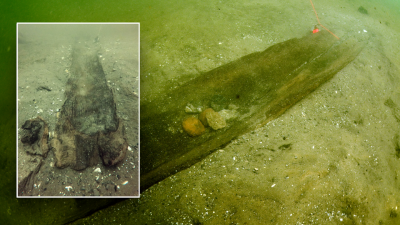 Lake Mendota - Historians from Wisconsin have reported the amazing finding of at least eleven prehistoric canoes in Lake Mendota, which is close to Madison. Among the important discoveries is a canoe from 2500 BC. The findings were announced in a press release by the Wisconsin Historical Society on May 23. All the canoes varied in age, with the youngest one dating back to 1250 AD. The archaeologists explained that the canoes “may have been intentionally cached in the water during the winter months, a standard practice to keep canoes safe from freezing and warping.” The canoes were also discovered along a shoreline that has since been submerged, suggesting a previously unknown civilization once thrived in the area. Dr Amy Rosebrough, State Archaeologist for the Wisconsin Historical Society mentioned that divers also found stone tools in the water, suggesting the presence of an ancient village site, which has yet to be located. “Even without finding the village, the discovery of these canoes and the tools found within the first canoe reminds us that people have lived and worked alongside the lake for thousands of years,”. While the Ho-Chunk tribe once lived in the area surrounding Lake Mendota, the Paleo-Indian people were the earliest inhabitants arriving around 12,000 years ago – the Ho-Chunk tribe migrated there no earlier than 800AD. Divers have found stone tools in the water, and experts believe that the lake is filled with other hidden sites.
Lake Mendota - Historians from Wisconsin have reported the amazing finding of at least eleven prehistoric canoes in Lake Mendota, which is close to Madison. Among the important discoveries is a canoe from 2500 BC. The findings were announced in a press release by the Wisconsin Historical Society on May 23. All the canoes varied in age, with the youngest one dating back to 1250 AD. The archaeologists explained that the canoes “may have been intentionally cached in the water during the winter months, a standard practice to keep canoes safe from freezing and warping.” The canoes were also discovered along a shoreline that has since been submerged, suggesting a previously unknown civilization once thrived in the area. Dr Amy Rosebrough, State Archaeologist for the Wisconsin Historical Society mentioned that divers also found stone tools in the water, suggesting the presence of an ancient village site, which has yet to be located. “Even without finding the village, the discovery of these canoes and the tools found within the first canoe reminds us that people have lived and worked alongside the lake for thousands of years,”. While the Ho-Chunk tribe once lived in the area surrounding Lake Mendota, the Paleo-Indian people were the earliest inhabitants arriving around 12,000 years ago – the Ho-Chunk tribe migrated there no earlier than 800AD. Divers have found stone tools in the water, and experts believe that the lake is filled with other hidden sites.
The 4,500-year-old Wisconsin canoe was built around the same time that Stonehenge was being constructed - Arkeonews